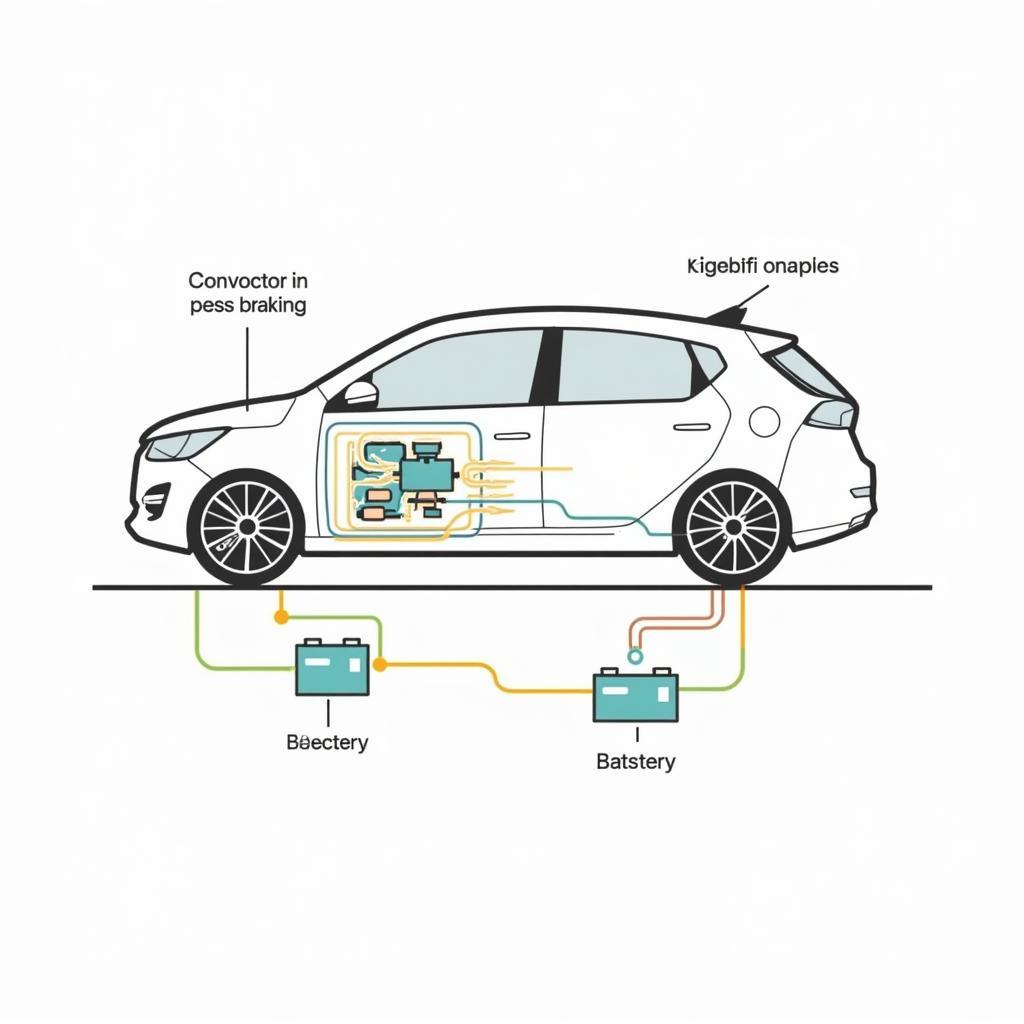Regenerative braking is a key feature in electric cars, offering improved efficiency and range. However, like any technology, it can present problems. This article explores common issues and solutions with regenerated breaking in electric cars, offering valuable insights for owners, mechanics, and technicians.
Understanding Regenerative Braking
Regenerative braking captures kinetic energy normally lost during deceleration and converts it back into electricity, recharging the battery. This process not only extends the driving range but also reduces wear and tear on traditional brake components.  Electric Car Regenerative Braking System Diagram
Electric Car Regenerative Braking System Diagram
Common Problems and Solutions with Regenerated Breaking in Electric Cars
Regenerated breaking systems can sometimes malfunction or behave unexpectedly. Here are some common problems and their solutions:
Reduced Regenerative Braking Performance
One common issue is a noticeable reduction in regenerative braking effectiveness. This can be due to several factors:
-
Low Battery State of Charge (SOC): When the battery is near full charge, it has limited capacity to accept more energy. This can significantly reduce or even disable regenerative braking. Solution: If you consistently experience reduced regeneration, consider adjusting your charging habits to avoid topping off the battery unless necessary.
-
Cold Temperatures: Battery performance can be negatively impacted by cold weather, affecting regenerative braking. Solution: Pre-conditioning the battery, if your vehicle offers this feature, can improve performance in cold temperatures.
-
Faulty Sensors: Sensors that monitor wheel speed, brake pedal position, and battery state can malfunction, leading to reduced or erratic regenerative braking. Solution: A diagnostic scan tool can identify faulty sensors. Replacement is usually the best course of action.
 Diagnostic Scan for Electric Car Regenerative Braking
Diagnostic Scan for Electric Car Regenerative Braking
Brake Pedal Feel Issues
Some drivers report a different brake pedal feel with regenerative braking compared to traditional braking systems. This can include:
-
Spongy Pedal: A soft or spongy brake pedal can indicate a problem with the brake hydraulic system, independent of the regenerative system. Solution: Check the brake fluid level and condition. If the fluid is low or contaminated, it needs to be addressed. Bleeding the brakes might also be necessary.
-
Grabby Brakes: Regenerative braking can sometimes engage abruptly, leading to a jerky or grabby feeling. Solution: In some cases, a software update from the manufacturer can address this issue. If the problem persists, further diagnostics may be required.
Unusual Noises
Unusual noises during braking can also be related to the regenerative braking system:
- Whining or Grinding: These sounds can indicate a problem with the electric motor or the regenerative braking system components. Solution: This requires immediate professional attention. A qualified technician should diagnose the issue to determine the source of the noise and recommend appropriate repairs.
Maximizing Regenerative Braking Performance
Understanding how to optimize regenerative braking can help improve its effectiveness and extend your vehicle’s range:
- Anticipate Stops: By anticipating stops and slowing down gradually, you maximize the opportunity for regenerative braking.
- Use “One-Pedal Driving”: Many electric vehicles offer a one-pedal driving mode that maximizes regenerative braking, allowing you to slow down and even stop without using the brake pedal in many situations.
- Avoid Hard Braking: Hard braking often bypasses the regenerative system and relies solely on the traditional friction brakes, wasting energy.
Expert Insights
“Regenerative braking is a complex system, and diagnosing problems requires specialized knowledge and equipment,” says John Smith, Senior Electric Vehicle Technician at EV Tech Solutions. “Don’t hesitate to seek professional help if you experience any issues.”
Another expert, Jane Doe, Lead Engineer at Green Auto Innovations, adds, “Drivers can significantly improve their regenerative braking performance through mindful driving habits. Anticipating traffic flow and minimizing hard braking are key.”
Conclusion
Problem And Solution With Regenerated Breaking In Electric Cars can range from simple fixes to more complex issues requiring professional attention. Understanding the system’s functionality and common problems empowers owners and technicians to address issues proactively, maximizing efficiency and extending the lifespan of their electric vehicles. For further assistance, connect with AutoTipPro at +1 (641) 206-8880 or visit our office at 500 N St Mary’s St, San Antonio, TX 78205, United States.





Leave a Reply